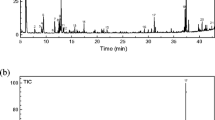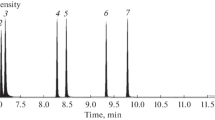Abstract
A method for measuring volatile fatty acids using ion-exclusion chromatography is presented. The system was found to be applicable to samples with high salt concentrations (e.g. seawater and marine pore water) when coupled with a vacuum distillation procedure. The method is straightforward, with no sample preconcentration and no introduction of external contamination. Calibration was found to be linear, with good reproducibility (coefficient of variation normally less than 5%) and the system was sufficiently sensitive to operate at the sub-ppm level (minimum detection limit for acetate and propionate was approximately 0.02 and 0.05 ppm, respectively). This technique was used to investigate the distribution of volatile fatty acids with sediment depth at Station E70 in Loch Eil, Scotland (sample was collected in March, 1983) and the results were in good agreement with recent publications. Although the system, at present, is limited in marine pore water to acetate and propionate, it has certain advantages over alternative systems and these are described.
Similar content being viewed by others
Literature cited
Ansbaek, J. and T. H. Blackburn: A method for the analysis of acetate turnover in a coastal marine sediment. Microb. Ecol. 5, 253–264 (1980)
Balba, M. T. and D. B. Nedwell: Microbial metabolism of acetate, propionate and butyrate in anoxic sediment from the Colne Point Saltmarsh, Essex, U.K. J. gen. Microbiol. 128, 1415–1422 (1982)
Banat, I. M., D. B. Nedwell and M. T. Balba: Stimulation of methanogenesis by slurries of saltmarsh sediment after the addition of molybdate to inhibit sulphate-reducing bacteria. J. gen. Microbiol. 129, 123–129 (1983)
Barcelona, M. J., H. M. Liljestrand and J. J. Morgan: Determination of low molecular weight volatile fatty acids in aqueous samples. Analyt. Chem. 52, 321–325 (1980)
Bethge, P. O. and K. Lindström: Determination of organic acids of low relative molecular mass (C1−C4) in dilute solution Analyst, Lond. 99, 137–142 (1974)
Christensen, D. and T. H. Blackburn: Turnover of 14C-labelled acetate in marine sediments. Mar. Biol. 71, 113–119 (1982)
Cochrane, G. C.: A review of the analysis of free fatty acids (C2−C6). J. chromat. Sci. 13, 440–447 (1975)
Hama, T. and N. Handa: Volatile organic acids in lake water; their gas chromatographic detection and ecological significance. Jap. J. Limnol. 42, 8–19 (1981)
Hungate, R. E.: The rumen and its' microbes, 533 pp. New York and London: Academic Press 1966
Jeris, J. S. and P. L. McCarty: The biochemistry of methane formation using 14C tracers. J. Wat. Pollut. Control Fed. 37, 178–192 (1965)
Jones, D. W. and J. J. Kay: Determination of volatile fatty acids, C1−C6 and lactic acid in silage juice. J. Sci. Fd Agric. 27, 1005–1014 (1976)
Jørgensen, B. B.: Mineralization of organic matter in the sea bed —the role of sulphate-reduction. Nature, Lond. 296, 643–645 (1982)
Lovley, D. R. and M. J. Klug: Intermediary metabolism of organic matter in the sediments of a eutrophic lake. Appl. envirl Microbiol. 43, 552–560 (1982)
Miller, D., C. M. Brown, T. H. Pearson and S. O. Stanley: Some biologically important low molecular weight organic acids in the sediments of Loch Eil. Mar. Biol. 50, 375–383 (1979)
Patience, R. L. and J. D. Thomas: Rapid concentration and analysis of short chain carboxylic acids: variation on a theme. J. Chromat. 234, 225–230 (1982)
Pearson, T. H.: The Loch Eil project: introduction and rationale. J. exp. mar. Biol. Ecol. 55, 93–192 (1981)
Richards, M.: Separation of mono- and dicarboxylic acids by liquid chromatography. J. Chromat. 115, 259–261 (1975)
Robbins, J. A. and J. Gustinis: A squeezer for efficient extraction of pore water from small volumes of anoxic sediment. Limnol. Oceanogr. 21, 905–909 (1976)
Sansone, F. J. and C. S. Martens: Determination of volatile fatty acid turnover rates in organic-rich marine sediments. Mar. Chem. 10, 233–247 (1981)
Sørensen, J., D. Christensen and B. B. Jørgensen: Volatile fatty acids and hydrogen as substrates for sulphate-reducing bacteria in anaerobic marine sediment. Appl. envirl Microbiol. 42, 5–11 (1981)
Turkelson, V. T. and M. Richards: Separation of the citric acid cycle acids by liquid chromatography. Analyt. Chem. 50, 1420–1423 (1978)
Tyler, J. E. and G. H. Dibdin: Method involving separation from biological material by vacuum distillation. J. Chromat. 105, 71–77 (1975)
Author information
Authors and Affiliations
Additional information
Communicated by J. Mauchline, Oban
Rights and permissions
About this article
Cite this article
Parkes, R.J., Taylor, J. Analysis of volatile fatty acids by ion-exclusion chromatography, with special reference to marine pore water. Mar. Biol. 77, 113–118 (1983). https://doi.org/10.1007/BF00396308
Accepted:
Issue Date:
DOI: https://doi.org/10.1007/BF00396308




